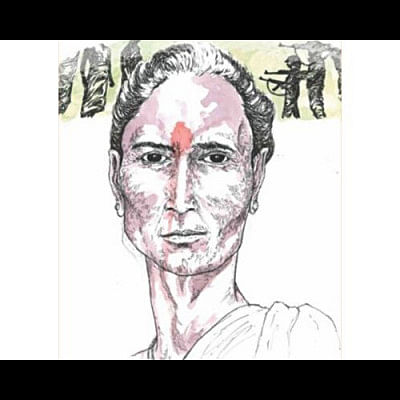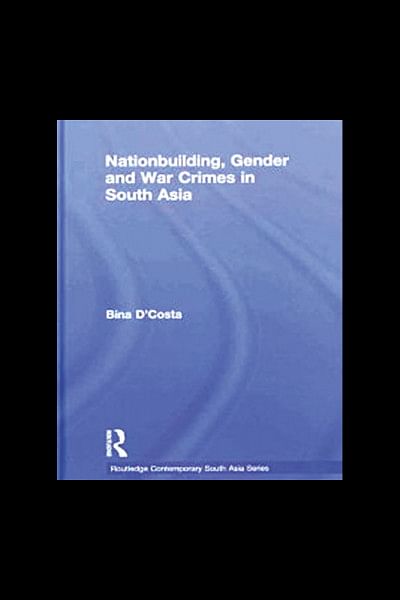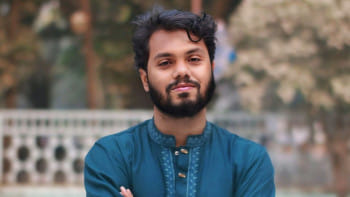The Birangana and the birth of Bangladesh

The year 1971 was a landmark in South Asian history for many reasons. It included the birth of Bangladesh but also the war fought by Pakistan and India. It was perhaps the only such conflict involving the three most populous South Asian countries, clashing for the first time since the end of colonial rule. High-level politics and the tumultuous times spawned a number of books on war, international relations and human rights. However, an uncanny silence has remained about one aspect of the war - the sexual crimes committed by the Pakistan Army and its collaborators, the Razakar militia, against Bangladeshi women. It is only now, 40 years on, that some of that silence is being broken.
Bina D'Costa's new Nationbuilding, Gender and War Crimes in South Asia takes on the mammoth task of placing violence against women during the war in a larger political context. While what D'Costa calls the 'original cartographic trauma' of the Subcontinent has been well researched, gendered nation-building narratives have been given little consideration. Yet D'Costa proposes that any theorisation of nation-building in post-Partition India and Pakistan, or post-Liberation Bangladesh, is incomplete without a gendered analysis. Recognising that women have largely been silenced by state historiography, feminist scholars and activists in Southasia - Veena Das, Kamla Bhasin, Ritu Menon, Urvashi Butalia - have attempted to explore this sordid aspect of war.

That rape has been used as a weapon of war has been well documented. One of the more famous examples is American feminist Susan Brownmiller's investigation of rapes committed during the two World Wars, in Vietnam and then in Bangladesh, which emerged as the 1975 classic Against Our Will: Men, women and rape. The idea of defiling the enemy population by raping its women and impregnating them, often while their helpless and 'feminised' menfolk watch, is based on notions of honour, purity and emasculating the opposition. These notions of defilement also led to the sacrificial killing, sometimes by their own families, of women who had either been raped or even simply exposed to the potential of sexual violence.
These 'honour' killings were widespread during the Partition riots of 1947, a phenomenon documented by Bhasin and Menon. Expanding on this theme, Butalia has talked about how women also colluded in maintaining family 'purity' by forcing those who had been raped to commit 'suicide'. The post-Independence 'recovery' programme, whereby abducted women and children were sent back to their families, was fraught with problems, precisely because of prevalent notions of desecration and impurity, which hindered acceptance by families and communities. We see a similar drama played out with the birangana, or rape survivors, and war babies of 1971.
Psychiatrist Ruth Seifert defined rape not as an aggressive manifestation of sexuality but as a sexual manifestation of aggression. Her study of sexual violence during World War II exposed a hitherto little-known side of that period. Seifer writes:
Soldiers of Nazi Germany also committed rape on a massive scale. It is furthermore known that the Wehrmacht ran brothels where women were forcibly made to work. In the Eastern territories, the Wehrmacht used to brand the bodies of captured partisan women - and other women as well - with the words 'Whore for Hitler's troops' and use them accordingly.
Helke Sander and Barbara Johr, in their research on the mass rapes of German women by Red Army troops at the end of World War II, allege that between April and September 1945, nearly 110,000 of Berlin's 1.4 million female residents were raped, and about 1,000 infants were born as a result. While many have criticised Sander and Johr's methods, it is undeniable that rape was part and parcel of the strategy of the victorious army to subdue the once-ascendant community. The silence around this aspect of the war also follows a pattern of denial evident in wars throughout history.
Sexual violence and rape during conflict have only recently been recognised as war crimes in international law. Women's experiences of sexual violence and rape in Rwanda, Bosnia and Congo were classified as war crimes and as crimes against humanity. Feminist scholars such as Kelly Askin's re-reading of the Nuremberg and Tokyo trials following the genocide of Jews during World War II have highlighted the failure of the international community to prosecute gender-specific crimes.
WARS AND THEIR HEROINES
An analysis of 1971 cannot be complete without examining 1947. The wound of Partition -cleavages of territory and populations - continued to fester, impinging on almost every aspect of life in India and Pakistan. D'Costa provides an insightful historical backdrop against which we can understand why Partition was almost inevitable, and why, in turn, the foundations had already been laid for the birth of Bangladesh, 24 years later. Reinvented and fractured identities, moving from 'Indian' to 'Pakistani' to 'Bangladeshi' with gradual anti-India and pro-Pakistan leanings, have complicated the pursuit of the war-crimes agenda in Bangladesh. More specifically, it has ensured that the story of women during the war has remained largely in the realm of propaganda, deployed for nationalistic purposes when suitable and then relegated to an uncomfortable corner of history.
D'Costa's is not the first writing on sexual violence during the Liberation War. Nilima Ibrahim, a social worker during the war, published Ami Birangana Bolchi (I am the Birangana spaking) in 1994, followed by the publication of the oral-history project undertaken by the Ain O Shalish Kendra (ASK). More recently, to mark the 40th year of liberation, feminist publisher Women Unlimited published Yasmin Saikia's Women, War and the Making of Bangladesh, a work based on oral testimonies of women who had suffered rape and D'Costa, however, steers clear of essentialising women or invoking any 'common interest' among women that supersedes class, ethnic or religious identity. D'Costa also eschews the voyeurism inherent in oral testimonies, the use of which represents an ethical dilemma with which sensitive researchers through the ages have grappled. What do the horror stories and personal pain, the cries of anguish and the desperation of revenge, add to our understanding of the narrative of rape or the politics of silence? Do the anguished words of women kept confined and raped repeatedly by enemy soldiers drive home the reality of violence more effectively? How comfortable are the women with having their lives exposed, and can their vulnerability enable them to give genuine informed consent to the interview and its subsequent publication? What is the long-term impact of the interview process on already traumatised women having to recount the horrific past? Grappling with these questions, and despite having interviewed several biranganas, especially in the rural areas, D'Costa instead chooses to publish already existing testimonies, such as those collected by the ASK.
Birangana, meaning 'war heroine', was a term coined by Sheikh Mujibur Rahman, Bangladesh's founding prime minister, as a way of acknowledging these women's 'sacrifice' for the freedom of Bangladesh. Mujib claimed that about 200,000 Bengali women had been raped by Pakistani troops. These numbers were never proved, however, nor were the perpetrators of rapes or killings ever brought to justice. Instead, these women began their lives in the newborn country under a shadow of shame. While the moniker was originally meant to honour all women - political activists, freedom fighters and rape survivors - it slowly became a term to identify those subjected to rape and sexual violence during the war.
Ironically, rather than honouring or dignifying them, this term became a label to mark a 'fallen woman' (birangana, meaning prostitute, is phonetically too close to 'birangana' for comfort). In turn, this prompted activists to coin a new phrase: nari jodha, or women fighters. Likewise, the attempt to wipe out all visible evidence of the women's 'impurity' - the babies born of the rapes - by encouraging large-scale international adoption had serious implications not only for the women and their babies, but also for the social workers involved in the process, who were complicit in furthering the government agenda.
There are echoes here of the intense emotional dilemmas faced after Partition by social workers trying to re-unite families in Pakistan and India. Anis Kidwai's memoir, Azadi ki Chao Mein, first published in Urdu in 1949, and recently translated into English as In Freedom's Shade by her granddaughter Ayesha Kidwai, is a moving and nuanced account of her experiences as a social worker involved in 'recovery' efforts. D'Costa interviews Nilima Ibrahim, Maleka Khan, Margaret Mary, Geoffrey Davis and nuns from the Missionaries of Charity in Kolkata, revealing that Bangladeshi social workers associated a similar anguish with their own mission. These testimonies also display the prevalent patriarchal view of women's bodies and motherhood. Nilima Ibrahim's account of her conversation with Mujib over the future of the 'war babies' is telling: "No apa, please send away the children who do not have their father's identity. They should be raised as human beings with honour. Besides, I do not want to keep that polluted blood in this country."
The popular proclivity to pity the birangana is shaken when some of the women share stories in which they do not easily fit into the roles of victims. Sculptor Ferdousi Priyobhashini's tale is one that speaks powerfully of the complexity of survival in a wartime situation, the role of the individual and the interplay of violence, emotion and sexuality. In her mid-20s in 1971, Priyobhashini was abducted by the Pakistan Army. Rescued from a 'rape camp' by an officer with a soft spot for her, she says:
"I also started to love him. Maybe it was just an infatuation or just to stay alive. Maybe that love was of gratitude. But just because a Pakistani saved my life, I couldn't marry him and go to Pakistan. In that way I would've only betrayed my country."
Dubbed a collaborator because she did what she could to survive in the circumstances, Priyobhashini was denied recognition as a birangana, although she had been raped and tortured for nine months. When, in the euphoria following liberation, she was sacked from her job at the jute mill for being 'anti-national', Ferdousi fell silent. She spoke up only 28 years later, first telling her story to ASK and subsequently going public in the local media.
THE RIGHT TO SPEAK
While following in the post-colonial tradition of challenging feminist scholarship of the Global North, D'Costa does not pull punches when calling for the need to analyse the authenticity and position of Southern feminists, who, with a few exceptions, are from privileged backgrounds, speak English and were trained in Western institutions, where many of them are still located. Yet the author also acknowledges that respondents, especially women, may be "more comfortable speaking with women researchers from locations other than their own, as the power inequality is at times quite visible between southern researchers and respondents." Referring to the complicated interplay between 'sameness and difference', she concludes, "We can no longer afford to argue about who has the right to represent, or whose representation is more 'authentic'." In answer to the question of who can best represent the marginalised, D'Costa calls for more forthrightness about research commitments. "We should be able to say what we have to say while being aware of the politics of location," she writes.
D'Costa's point is especially relevant, given the reaction to another significant book published in 2011 to mark Bangladesh's 40th year of liberation: Sarmila Bose's Dead Reckoning: Memories of the 1971 Bangladesh War. It is not Bose's Indian origins that should come under the scanner but the dubious methods employed in her work. Bose's controversial Dead Reckoning, which questions the scale of the killings and rapes and disputes the genocidal character of the violence, generated a predictable storm of protest in Bangladesh as well as corresponding sighs of moral relief in Pakistan, which is still weighed down by collective guilt over allegations of sexual violence and torture perpetrated by the Pakistan Army. Bose refutes the popular Bangladeshi claim of three million dead, and prefers instead to rely on the figure of 26,000 dead put forth by the Hamoodur Rahman Commission. The first report by this commission - constituted by the Bhutto government to investigate both the causes of the ignominious defeat and the claims of atrocities committed by the army against the local populace - was never published. The controversy it raised within Pakistan perhaps convinced Bose of its veracity.
Dead Reckoning does seem to accept the Pakistan Army officers' version of events in good faith. In her reconstruction of some notorious events, such as the massacre in Joydebpur on March 19, 1971, Bose chooses to conclude, for example, that the death toll did not come to 20 people (as the Bengalis claimed) but only to two. An examination of Bose's methodology must consider respondent fatigue and the construction of narratives in response to research questions, where the framing of the question can guide the response. These are daunting challenges for researchers in any field, the more so when the research focuses on fraught human lives, anguished memories and profound trauma.
D'Costa boldly proposes that crimes against women - rape, pregnancy, abortion, and the forceful separation of mothers and their children born as a result of rape - were not an unfortunate by-product of war, but inherent in the very premise of the nation-building project. She goes on to show how the new state of Bangladesh, in building its national identity, attempted to provide space for the co-existence of Islam and Bengali ethnic identity and also promoted communal harmony. "In this new patriotic space, which required nationbuilding to make peace with the two conflicting identities (the religious and the ethnic), it was crucial to silence women's experiences of the Liberation War." The post-Independence rise of the Islamic right in Bangladeshi politics, as well as clashes between secular and communal forces, remains an ever-present reality in Bangladesh today, much as it does in India.
Yet, as Ruth Seifert points out, bringing the matter of violence back into the cultural consciousness and making it public is the sine qua non for change. "Only when sexual violence is perceived as a political issue, when it is publicly discussed and analysed, will it be possible to establish the causes and contexts and to envisage strategies to overcome this situation," she says. Official rehabilitation efforts apart, one notable finding of D'Costa's research is the informal network of rape survivors, many of whom have kept in touch with each other, offering financial, emotional and other forms of assistance. This is particularly heartening given the lack of transnational feminist mobilisation around the birangana, which stands in sharp contrast to the movement for justice regarding Korean comfort women, to whom Japan has officially apologised. This is perhaps because the women's movement within Bangladesh was unable to elevate its post-war efforts above considerations of charity and justice for individual women.
D'Costa urges that it is not too late for the Bangladeshi women's movement to amplify its voice, motivate action, and seek truth and justice. Her book provides ample material to trigger this significant campaign.
The writer is consulting editor at Himal Southasian, and director of the Hri Institute for Southasian Research and Exchange. The review is reprinted (with some editing) by permission of the HIMAL Magazine from its issue on 20 March, 2012.

 For all latest news, follow The Daily Star's Google News channel.
For all latest news, follow The Daily Star's Google News channel. 



Comments